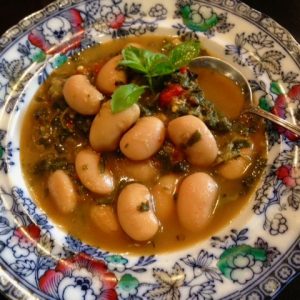My husband gifted me with 20 pounds of heirloom beans for my birthday. This would not be met with enthusiasm by some, but I am Our Lady of Legumes and I’ve been cooking my way through them with delight — Christmas limas with roasted peppers and salsa verde, alubia blanca with wild mushrooms, mint and asparagus, crusty limas with garlic, lemon and greens. It was a present for me, but everyone at our table benefits. I still have plenty to of pulses left to celebrate Global Pulse Day on Wednesday — the issue is, what dish would be worthy?
With a trip to Italy on the horizon, I thought of an Italian vegetable soup. I’m Italian not by heritage, but in spirit. By both tradition and necessity, Italian cuisine makes much from little, but there’s nothing little about the flavors. Big, bold and elemental, it’s one of the easiest cuisines to create at home, one of the most luscious ways to eat. So how would this play out? A bean-enriched minestra? Pasta e fagioli? Ribollita, that divine sludge of beans, broth and bread?
 Pulses are glad to share the spotlight with other ingredients, from a melange of seasonal vegetables to pasta and bread. For Global Pulse Day, though, I wanted to give them their time to shine.
Pulses are glad to share the spotlight with other ingredients, from a melange of seasonal vegetables to pasta and bread. For Global Pulse Day, though, I wanted to give them their time to shine.
I soaked a pot of fasolia gigantes — kingsized limas. They hold their own in a pot of soup, imparting oomph and starchiness without bread or pasta, yet they’re creamy to the bite and fun in the mouth. Then I went into the garden to consult my vegetables and see what they advised.
About my tomatoes, the less said, the better. But my peppers and basil are both doing well for the first season ever and I’d already harvested some chard that was starting to languish in my refrigerator. Well, then.
The next day, I roasted the peppers as I put the limas on to cook. When the limas were done, I added the peppers. I chopped the greens and gave them a quick sauté with garlic before adding them, then finished with a handful of chopped basil. It’s more than minestra, it has the comforting substance of a ribollita or a pasta e fagioli without the bread, pasta and tomato, yet it is its own entity, a winter meal in a bowl perfect for Global Pulse Day — or any day. Mangia fagioli (eat beans).
Gigante Global Pulse Day Soup
Ingredients
- 1 pound dried fasolia gigantes royal coronas or similar large limas, soaked overnight in plenty of water
- 3 quarts water or vegetable broth
- 4 garlic cloves whole
- 1 bay leaf
- 1 small dried red pepper crumbled or a pinch of dried red pepper flakes
- 2 tablespoons olive oil
- 2 large onions chopped
- 2 carrots chopped
- 2 stalks celery chopped
- 4 large red peppers*
- 1 tablespoon sherry vinegar or balsamic vinegar
- 1 bunch chard or other winter greens such as kale or spinach, tough stems discarded
- 1 tablespoons olive oil
- 2 cloves garlic chopped
- 1 handful fresh basil chopped fine
- sea salt and fresh ground pepper to taste
Instructions
Notes
* In a pinch, you can use an 8-ounce jar of roasted red peppers, drained, chopped and tossed with the sherry vinegar or balsamic vinegar. Add them at the end, along with the chopped basil, otherwise they'll dissolve into mush.



Leave a Reply